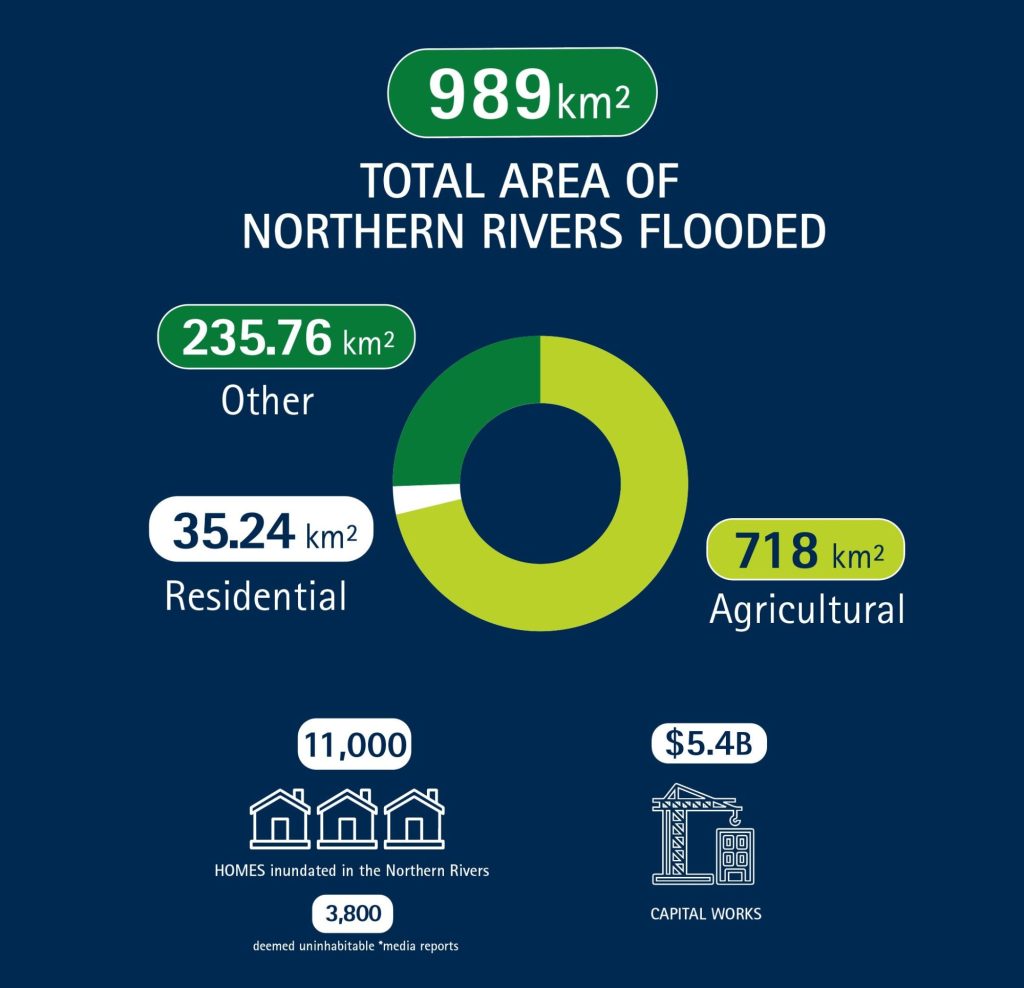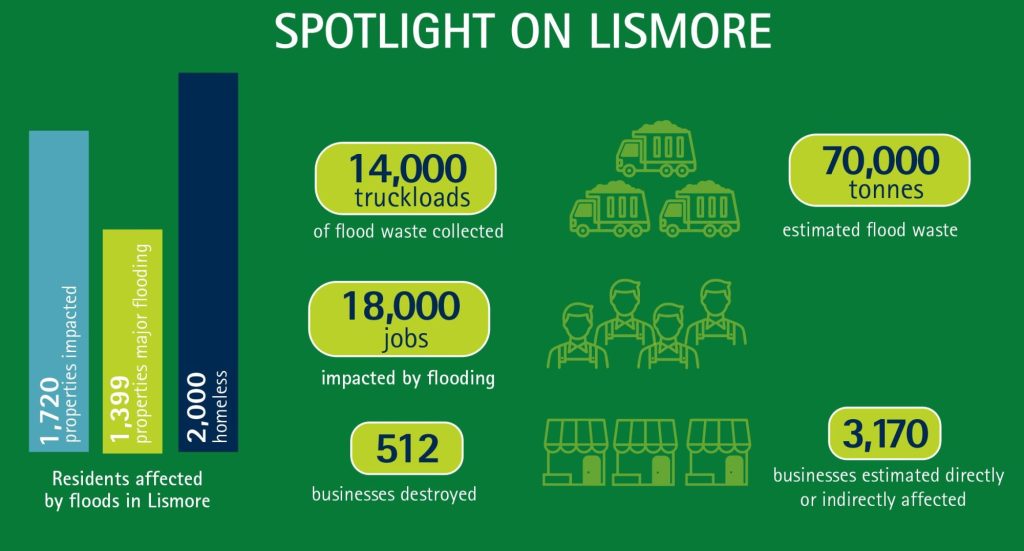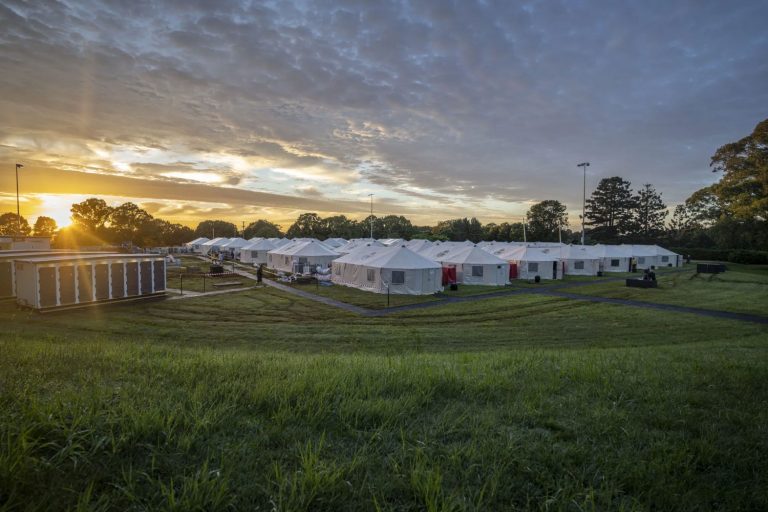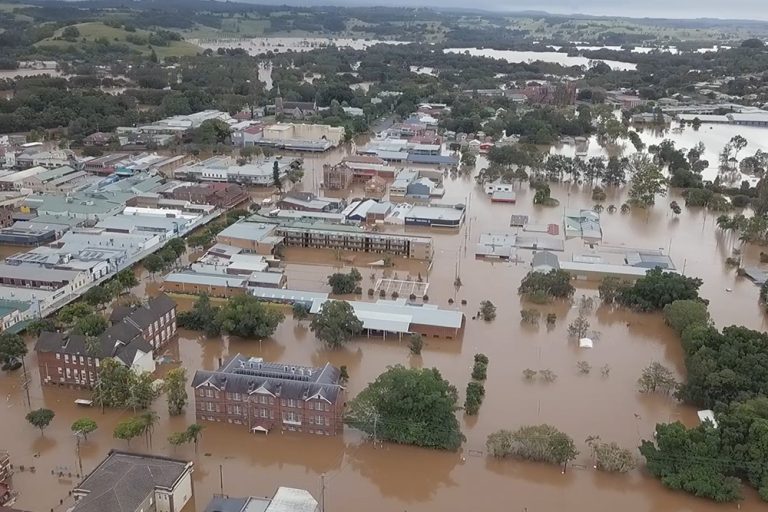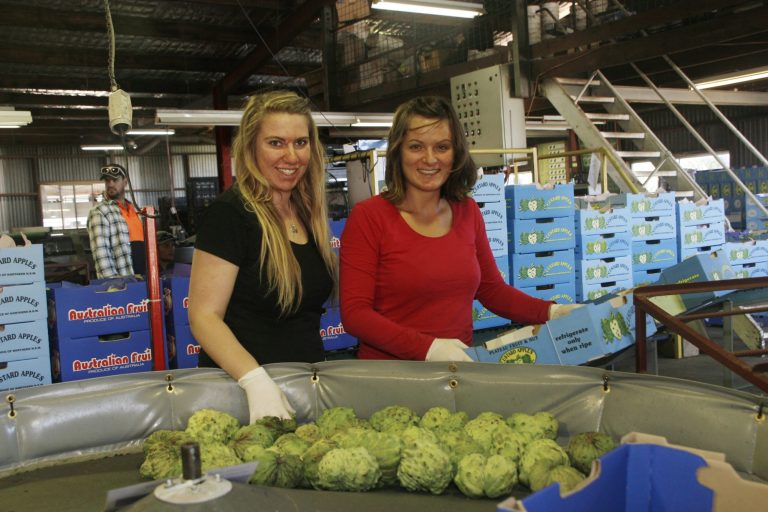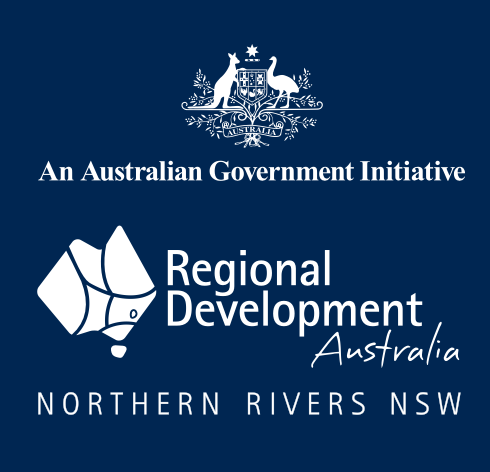RDA NORTHERN RIVERS
Regional Economic Recovery Plan 2025
Introducing Northern Rivers, NSW

Image: Alex Clarke
Background
Northern NSW / South East QLD Floods 2022
The disastrous flooding events which affected a vast area of eastern Australia from the end of February through March 2022 is now being calculated as the second worst natural disaster event in Australia’s history by insurance bodies. Since settlement, the region has a long history of living with rain events and floods, in fact the region is home to the top four highest rainfall locations in NSW. While the Northern Rivers was the economic lifeline of the early settlers, the first nation’s people were very aware of the energy and destruction caused by the major river systems, particularly where systems converged.
Regardless of history and experience, this event far exceeded all previous records catching even the long-time residents by surprise with the sheer speed which it rose to reach the record height of 14.4m in Lismore. The geographic size of the catastrophe was also an unfortunate first, with the low lying communities in all seven LGAs (Tweed, Byron, Ballina, Lismore, Richmond Valley, Kyogle and Clarence Valley) being directed to evacuate.
Livelihoods, housing, transport, infrastructure and businesses were completely destroyed across all seven council areas. The natural environment too, suffered greatly with the full cost of losses of flora and fauna unknown. Land slips will have a long term affect on access to some communities in Tweed Shire for some time to come. Primary production and rural landholders were also at the mercy of the largest flood in memory leading to millions of dollars of losses to many sectors including beef, dairy, sugar, horticulture, forestry, apiary and other primary production sectors.
Across the region over 10,000 people were displaced, 8170 damaged properties including thousands of severely damaged properties, 24,500 insurance claims and a public infrastructure and public works reconstruction effort valued over $5.4 billion. The private sector reconstruction will be a multiplier of many times this figure.
Read on below or Download the report
THE NATIONAL CONTEXT OF DISASTER RECOVERY
Community, local governments, NSW State Government and the Australian Government all have important roles to play within the context of rebuilding and recovering from disasters. However, while state governments take the lead during disaster events, effective recovery relies on coordination of agencies across the three levels of government and community organisations and individuals.
During declared disasters, the Australian Government collaborates with relevant state and territory governments. A main source of recovery funding is allocated through the Disaster Recovery Funding Arrangements (DRFA), managed by Emergency Management Australia. The National Recovery and Resilience Agency, now part of The National Emergency Management Agency, provides on the ground information and intelligence back to federal government agencies for policy and planning purposes. Services Australia is tasked to promptly deliver financial relief on the ground, often using mobile centres directly to community.
- The Commonwealth Government is responsible for administering the DRFA. These arrangements provide a financial safety net which supports significant recovery efforts within NSW.
- The Australian Defence Force (ADF) has capabilities and resources that can be useful in providing assistance during the recovery from natural disasters. The ADF provides this support under the Defence Assistance to the Civil Community (DACC) arrangements.
The National Emergency Management Agency (NEMA) has set out a national framework2 which incorporates Australia’s implementation of the Sendai Framework (the Framework):
“…the Framework articulates Australia’s 2030 vision for disaster risk reduction, which is broadly aligned with the goals of the Sendai Framework and the Sustainable Development Goals:
In Australia, we are enabled and supported to actively reduce disaster risk and limit the impacts of disasters on communities and economies.
All sectors of society understand and respond to social, environmental, technological and demographic changes which have the potential to prevent, create or exacerbate disaster risks. All sectors of society:
- make disaster risk-informed decisions,
- are accountable for reducing risks within their control,
- and invest in reducing disaster risk in order to limit the cost of disasters when they occur.
To meet this vision, the Framework outlines foundational strategies for action structured around four national priorities across the five years from 2019-2023:
- Understand disaster risk
- Accountable decisions
- Enhanced investment
- Governance, ownership and responsibility…”
State Governments have the ultimate authority in times of natural disasters. Large disasters can evoke a whole of state government recovery response. Departments such as Health, Education, Training and Infrastructure work with coordination agencies such as Public Works, Resilience NSW and Regional NSW to ensure services are delivered and infrastructure is recovered and rebuilt. The responsibility for the overall coordination of recovery operations in NSW rests with the State Emergency Recovery Controller (SERCON) unless prescribed in hazard specific plans (EMPLAN, Part 4, Section 406). The Northern Rivers Reconstruction Corporation is a lead actor for the region. Constituted on the first of July 2022, supported by a community advisory board and reporting to the Deputy Premier, its priority tasks have been outlined as accommodation/housing issues and rebuilding public infrastructure.
- Local council plays a key role in managing local recovery, providing services and assistance to the community and providing advice to State Government.
- Local councils participate in the establishment of Local Recovery Committees and serve as the chair when a Recovery Coordinator has not been appointed.
- Local councils provides expertise and local knowledge to inform the Local Recovery Committee.
- Local council provides executive support to the Local or Regional Recovery Committees.
- Local council provides a Recovery Centre Manager and administrative support to the Recovery Centre in circumstances where this service model is utilised.3
The 2022 NSW Floods Enquiry conducted by Mary O’Kane and Michael Fuller into the Feb-March flood disaster commended the communities’ leadership and commitment to selflessly saving lives and property of others. Any Regional Economic Recovery Plan needs to dutifully repay this commitment and ensure that community has a strong voice in its development, post-disaster. Northern Rivers traditionally places a high value on social licence and activities and actions which form part of a community’s recovery will be
no less accountable. Community response has been positive to the message of “building back better”. The challenge for reconstruction and recovery agencies is to meet community expectations of timeliness in rebuilding their communities.
The Strategic Regional Plan priorities are informed by stakeholder consultation and underpinned
by research and analysis. Led by a non-political community board, RDANR will continue to engage with all communities and leaders to deliver a Strategic Regional Plan which genuinely reflects the community needs, priorities, and expectations.
This plan will be a guide for much of the advocacy, facilitation and project development undertaken
by the Board and staff. RDANR’s Annual Business Plans will feed into, and draw from, this Regional Economic Recovery Plan to ensure integration of the Recovery Priorities and successful implementation and coordination of the key action items.
2 https://nema.gov.au/about-us/policies/strategies-and-frameworks accessed 15 September 2022
3 NSW Recovery Plan, NSW Government, 2021
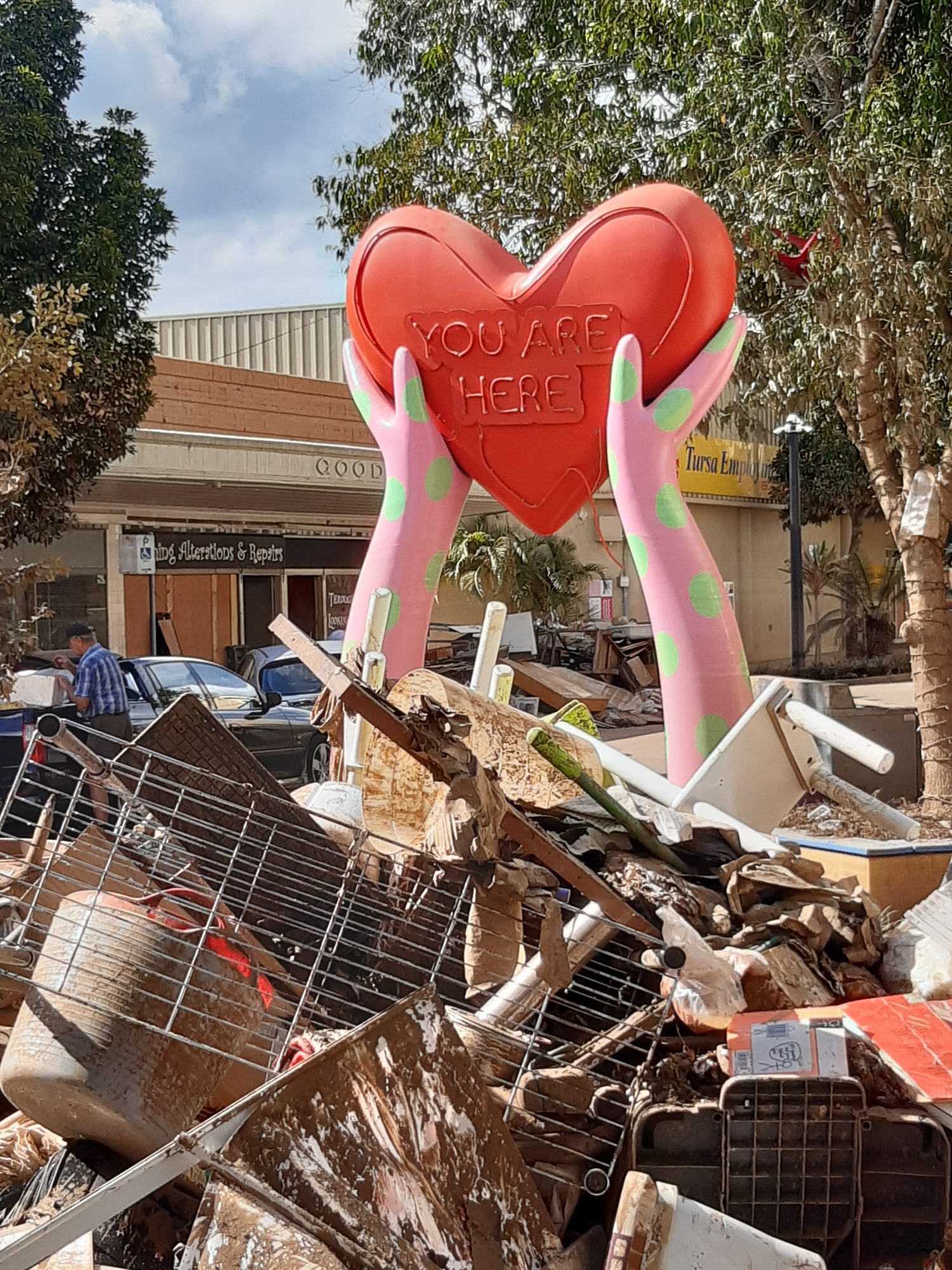
Image: Liina Flynn
TOWARD A FULL ECONOMIC RECOVERY
The recovery “phase” is not a singular period. Recovery is best conceived in terms of the short, medium and long term. In the case of the Northern Rivers disaster, not all areas will recover at the same time, and it is expected that some of the most highly impacted areas will require many years of rebuilding.
Recovery activities respond to short, medium and long-term timelines in four key areas: social, built environment, economic, and natural environment. This Recovery Plan focuses on the third environment, the economic and financial. Of course, the four areas are not mutually exclusive and are often inextricably linked and so priorities for recovery can fall across the spectrum. For example, accommodation and housing is an important issue which falls within the social, built environment and economic spheres.
“The impacts of disasters on affected individuals and communities can be profound, long lasting and life changing. Therefore, recovery is a long-term, multi- layered social and developmental process that is more than simply the replacement of what has been destroyed and the rehabilitation of those affected.”
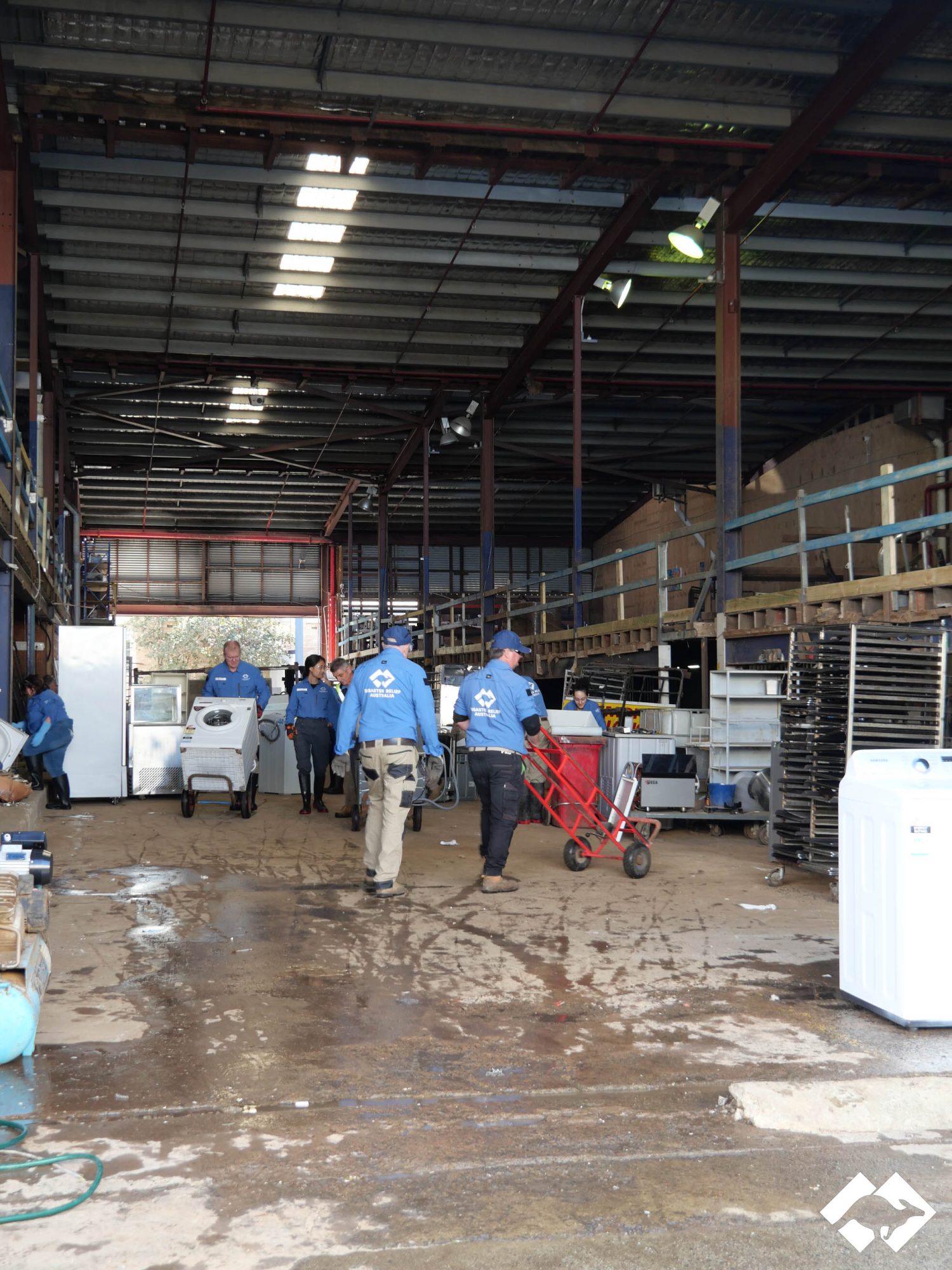
Image: Disaster Relief Australia
THE
RECOVERY
PHASE
This section proposes a vision for the region which aims to set a future state for all communities. As a highly collaborative region, this section also seeks to establish how frameworks can be improved to ensure a comprehensive and joined up response between community actors and responsible agencies.
Image: Kate Atkinson
Vision for Recovery
Communities are successful at dealing with future disasters and are continually working to reduce risks leading to an improved outlook for financial health and well being
- Guiding principle
- Our desired future character
When realised, the vision will result in outcomes that represent the desired future character:
- A region which acknowledges and plans for environmental challenges and is better equipped to mitigate future disastrous events.
- Communities are resilient and seek new opportunities while building on their recognised strengths
- People are mentally and physically healthy and have access to all areas of healthcare. They have confidence in themselves and the future of their communities
Recovering Through Collaboration
Promoting collaborative partnerships and regional planning
Community engagement
RDA-NR recognises the importance of broad regional engagement to help develop and deliver the Strategic Regional Plan. Regional engagement assists successful regional development policy making, program design and management, and service delivery activities.
RDA-NR recognises the importance of broad regional engagement to help develop and deliver the Strategic Regional Plan. Regional engagement assists successful regional development policy making, program design and management, and service delivery activities. Continuous engagement with communities across the region, as well as utilising local knowledge and skills, will help deliver a Strategic Regional Plan that genuinely reflects community needs, priorities and expectations. Community knowledge and expertise is also required to inform and guide regional development activities.
Regional collaboration and partnerships
This plan builds on the foundation of strong regional partnerships and collaboration with stakeholders. The complexity of many of the priorities means that they cannot be fully implemented or actioned by any one agency.
This plan builds on the foundation of strong regional partnerships and collaboration with stakeholders. The complexity of many of the priorities means that they cannot be fully implemented or actioned by any one agency. Successful outcomes require the support and co-ordination of local government, state and federal agencies, the health, education and training sectors, regional organisations, industry, business, community service and not-for-profit organisations.
Harnessing collaborative regional leadership and establishing effective regional partnerships are key themes throughout. Strong leadership and governance are fundamental enablers of regional development and are characterised by; working to a collective vision, taking cooperative approaches to community engagement, knowledge-sharing, planning, project design, and implementation of strategies and activities. Hence regional collaboration is fundamental to the successful implementation of this plan.
Integrated planning
The proposed planning framework here provides a strong connection between the Northern Rivers Strategic Regional Plan 2025 and the RDA Northern Rivers Annual Business Plan, which seeks to build internal organisational capacity to respond to regional challenges.
The proposed planning framework here provides a strong connection between the Northern Rivers Strategic Regional Plan 2025 and the RDA Northern Rivers Annual Business Plan, which seeks to build internal organisational capacity to respond to regional challenges.
This Regional Economic Recovery Plan aligns with Australian Government priorities (below) and will integrate with NSW agency planning and local government disaster recovery plans where they exist. This plan is an attempt to synthesise and refine the relevant documents and create a holistic Regional Economic Recovery Plan which relates to the circumstances faced by the Northern Rivers communities.
In Australia, we use the National Principles for Disaster Recovery to guide our efforts, approach, planning and decision making4. These principles, outlined below, act like a checklist to inform actions and ensure they meet community needs.
OUTLINING THE PRINCIPLES OF RECOVERY
| Understanding the context | Successful recovery is based on an understanding community context, with each community having its own history, values and dynamics. |
| Recognising the complexity | Successful recovery is responsive to the complex and dynamic nature of both emergencies and the community. |
| Use community-led approaches | Successful recovery is community- centred, responsive and flexible, engaging with community and supporting them to move forward. |
| Coordinate all activities | Successful recovery requires a planned, coordinated and adaptive approach, between community and partner agencies, based on continuing assessment of impacts and needs. |
| Communicate effectively | Successful recovery is built on effective communication between the affected community and other partners. |
| Recognise and build capacity | Successful recovery recognises, supports, and builds on individual, community and organisational capacity and resilience |
AIDR, 2022
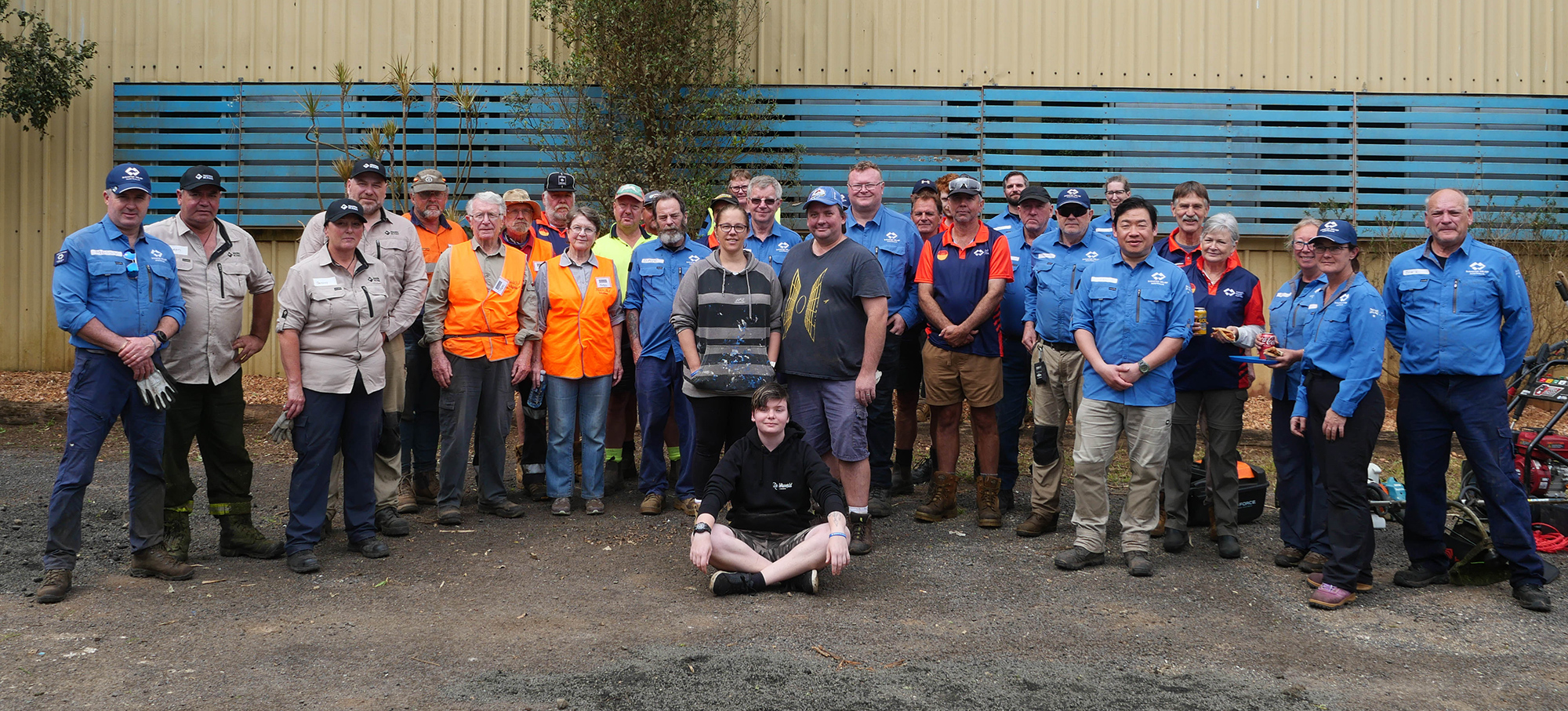
Image: Disaster Relief Australia
REGIONAL ANALYSIS:
NORTHERN RIVERS DISASTER DASHBOARD
| IMPACT | TOTAL AREA FLOODED | AGRICULTURAL LAND FLOODED | RESIDENTIAL LAND FLOODED |
|---|---|---|---|
| BALLINA | 66 sq km (14% of Ballina) | 51 sq km (16% of agricultural land) | 4 sq km (8% of residential land) |
| BYRON | 12 sq km (2% of Byron) | 1 sq km (0.4% of agricultural land) | 3 sq km (4% of residential land) |
| CLARENCE VALLEY | 402 sq km (4% of Clarence Valley) | 284 sq km (9% of agricultural land) | 9 sq km (7% of residential land) |
| KYOGLE | 2 sq km (0.1% of Kyogle) | 1 sq km (0.1% of agricultural land) | 0.24 sq km (0.9% of residential land) |
| LISMORE | 203 sq km (16% of Lismore) | 170 sq km (18% of agricultural land) | 5 sq km (7% of residential land) |
| RICHMOND VALLEY | 219 sq km (7% of Richmond Valley) | 146 sq km (13% of agricultural land) | 8 sq km (14%of residential land) |
| TWEED | 85 sq km (6% of Tweed) | 66 sq km (11% of agricultural land) | 6 sq km (4% of residential land) |

REGIONAL
RECOVERY
PRIORITIES
Regional Priorities
Communities need to see reconstruction and recovery action on the ground in order to regain confidence and reassurance in their leaders. After disaster, many in the community will feel that solutions to their own personal situation may be out of their control. Therefore, a prompt response by authorities to begin the reconstruction and rebuilding of important community assets is critical to the welfare of all communities. The below actions have been identified by the RDANR Board as priority areas which RDANR can lead or support from the short term and into the future. Of course, this work represents only the smallest proportion of the vast reconstruction effort that still faces many communities.
- Accommodation and housing
– Short term emergency accommodation for those without suitable housing due to flood relocation. This will include innovative solutions, assisting proposed programs such as pods.
– Medium term transitionary housing and accommodation leading to more long-term sustainable solutions, including permanent relocation similar to Grantham (Qld) experience, voluntary acquisition and voluntary house raising.
– Long term appropriate social and affordable housing that satisfies the regional demand using innovative as well as traditional models. - Employment land audit (in collaboration with NRJO)
– Audit of Employment land, both private and publicly held. The audit will incorporate analysis of susceptibility to natural disaster. Identification of potential Employment land will also be valuable for planners and the development industry.
– Audit of residential land, to identify suitable flood free land in each LG, noting publication of findings will need to be classified confidential. - Business and Industry recovery
– Provision of advice for grants and assistance, reactive and proactive workload.
– Advocating for expedited delivery of funding to all applicants
– Participate actively on recovery committees, advocate for policy and program improvements, provide
intelligence from the business community and liaise between committee and federal government program deliverers and managers. - Local Buy, Supply Chain development
– Supplier capability/ Buyer program (via development of online platform)
– Driving campaigns to ensure recovery and rebuild programs have inbuilt local purchasing policies.
- Infrastructure, assist LG with grants, tenders etc.
– Assist councils to access large infrastructure grants for building betterment Northern Rivers, NSW Regional Economic Recovery Plan 2025
– Assist with resilience planning for key infrastructure - Employment and workforce development
– Some of the more complex work of the entire program. Over 9000 displaced workers and hundreds of businesses will require a regional plan, resourcing, innovative thinking, and solutions
– Provide employers and workers with timely assistance for training, reskilling, workforce development and displaced worker programs - Flood Mitigation
– Maintain an advocacy role for flood mitigation, water security and water quality.
– Liaise with all levels of government including Rous Water to deliver effective and timely infrastructure to
mitigate future flood impacts.
- CBD and main street redevelopment
– CBD and Main St are the heart of many communities, and it is imperative that these spaces are quickly rebuilt and resettled.

RDANR REGIONAL RECOVERY PRIORITIES
PRIORITY ACTIONS
The need to rapidly provide appropriate accommodation for members of the community displaced by natural disasters is the most immediate and important concern of response and recovery agencies. In the Northern Rivers, as with many regional areas in Australia, the availability – and affordability of housing and accommodation is at a crisis point meaning that identifying suitable accommodation at short notice for thousands of displaced people is impossible. In this instance the NSW government established Recovery Centres around the region as the most appropriate response during and immediately following the flood but is now establishing locations around the region with short term solutions such as “pod villages”.
Housing affordability (relative to average incomes) is already a challenge throughout much of the region and there is a lack of housing for some members of the community, e.g., 1-2 bedroom units for younger people and students, affordable housing for low income families, and so on. The lack of available housing for key workers was already a major concern for businesses, now greatly exacerbated by the flood.
In the medium term, the region will look to either building new, refurbishing or allocating housing and accommodation as a transition to longer term accommodation as the pod precincts become less appropriate for those with longer term needs. Given the thousands of people whose homes were completely destroyed, severely damaged or otherwise made uninhabitable, the government must consider all options for permanent resettlement. This could be by voluntary relocation, buy back, voluntary house raising schemes or other programs with a goal of giving long term sustainable solutions for all residents. For those where it makes sense to resettle back in place, assistance must be made available to rebuild with flood mitigating planning, infrastructure and materials.
The Northern Rivers Reconstruction Corporation (NRRC) has been established as the lead agency for much of this work and RDANR will be working closely with this agency to assist the communities to get back on the road to recovery. The NRRC has already signalled its intention to garner best practice from around Australia including programs used by Queensland Reconstruction Authority which had success relocating the Grantham community following the 2011 flood.
Long term, appropriate social and affordable housing resettlement, either in place or via relocation, will require high levels of consultation with communities. Success will lie in the ability of the leaders to implement place-based solutions using a combination of innovative and traditional models.
RDA Northern Rivers and Northern Rivers Joint Organisation have partnered with the seven councils to engage a consultancy to audit industrial and employment land across the Northern Rivers. This body of work was identified as a priority prior to the 2022 floods and, due to the effect on supply of industrial land and buildings, the urgency and importance of such an audit has grown in significance.
Specifically, the report will assess demand and supply of lands looking forward 20 years and beyond, identify the likely demands for various employment and industrial land uses, considering global, domestic and local trends and provide commentary of the economic, social and environmental values and issues related to various land uses.
At time of writing the consultancy HillPDA has been appointed to undertake the work and the final report is due to be presented for the steering committee’s consideration in January 2023.
A profitable and innovative SME business and industry sector is a principal driver of regional economic development. The growth of the Northern Rivers economy in the longer term will be realised through a mix of reinvestment into existing industries, strategic attraction of new or complementary businesses and the nurturing of emerging industries. A healthy economy is one which offers meaningful full-time employment across a diversity of skill sets. These industries will capitalise on the region’s lifestyle attributes and its natural comparative advantages to enhance our appeal as an investment location and a place in which to live, work and do business.
Employment opportunities across the three “functional economic regions” as designated by NSW government rely heavily on retail, health care and social assistance, and the hospitality sector. Over the past six years, compared to the NSW average, the region’s unemployment rate has been lower than state averages but also has low labour force participation. Underemployment and casualisation of the workforce have also been a sustained characteristic.
According to the ABS Business Counts data, in June 2020, 64.4% of the total number of businesses in the Northern Rivers were non-employing (micro- businesses/sole traders). Another 33.7% employed fewer than 20 people; 1.9% employed between 20 and 199 workers and larger businesses employing greater than 199 people numbered just .03%. Image: Lismore City Council REGIONAL ECONOMIC RECOVERY PLAN 2025 27 The region’s business profile differs to the employment profile, with construction accounting for 17%, agriculture, forestry and fishing accounting for 16.5% of regional businesses and construction for 17%. There are also high levels of businesses involved in professional, scientific and technical services (11%), rental hiring and real estate services (10%), and 8% retail trade. (REMPLAN, 2022).
Industry specialisations in the region range across manufacturing (particularly food and wood products, textiles, clothing and footwear), retail trade and personal and community services (particularly health- related and residential care services). The region’s creative industries are also well-represented by the publishing, screen and performing arts sectors.
Diversifying the region’s industry base is necessary to grow local business and provide a variety of meaningful and sustainable employment opportunities for all members of the Northern Rivers community. There is a desire to leverage the region’s existing attributes and capacities to grow regional competitive advantage, particularly in the fields of education, health care including mental health, sustainable and high quality ‘food and fibre’ production and the visitor economy.
As the world moves past the Third Industrial Revolution of digitisation, which begun last century, into an emerging Fourth Industrial Revolution, the region must ready itself to embrace a world in which the traditional boundaries between the physical, digital, and biological worlds become blurred. Already we have witnessed massive disruptions on the supply side with agile new companies rethinking how value can be created from ideation stage to additive manufacturing through to autonomous delivery using price, speed and quality to eliminate traditional business models. On the demand side consumer patterns of behaviour are shifting to drive even greater changes in design, logistics and marketing of goods and services.
There are also opportunities to support business innovation and the development of emerging industries including the renewable energy sector, creating value from waste resource, designing out waste altogether and embracing ‘circular economy’ principles.
The region’s economic output is $34 Bn or 2.6% of New South Wales total output. The industry mix is relatively diverse but has few higher tier companies with the majority of construction and project-based companies falling into middle tier operators. As the reconstruction effort ramps up, these locally based businesses have a value proposition which should be meaningful for larger prime contractors that will be managing major project rebuild packages. Local companies know and understand local conditions, have trained staff who don’t need accommodation, have developed their own extensive networks and are led by a local decision maker, which can result in savings in cost and time for the project leads. This Recovery Plan acknowledges that some level of investment in programs to build capacity and capability in these locally based firms will need to be made. Not only because this investment should lead to successful tendering for respective work packages, but also to create a legacy of increasing in capability for the future. Recent history has shown us that during mining booms in regional areas, the successful regions were those where businesses learnt to tender cooperatively, invest in new technology and equipment, and commit to world best practice underpinned by quality training. Not only did these steps provide a pathway to work directly relating to the mining sector, but to other sectors as the mining tapered off, providing a resilience and focus on innovation that was largely absent beforehand. The reconstruction investment will provide a once in a generation level of investment and RDANR will support the state and local governments’ local procurement programs in addition to working closely with the relevant organisations such as ICN, and the prime contractors. The Northern Rivers NSW brand will be a useful tool to promote the capabilities of local suppliers.
The terminology of ‘build back better’ has been a catch cry which may be losing its currency, however, the intent behind it is in close alignment with this Recovery Plan. That is, to build in risk reduction and mitigation in the first place and ensure that building materials and equipment installed during the rebuilding phase are appropriate to withstand future flood events.
A resilient infrastructure plan will include embedding this methodology into reconstructed road networks, transport, energy, water and telecommunications infrastructure. The projected effects of climate change on our built environment will only exacerbate the need to seek new, and more resilient solutions to our future infrastructure needs.
Public infrastructure rebuilding will be managed through NRRC and Public Works who will liaise with councils and NSW agencies via specific funding such as Infrastructure Betterment Fund etc. Funding will often come through government allocations and grants and RDANR will support councils to access this funding on an ongoing basis. In addition, RDANR will continue to work with Northern Rivers Reconstruction Corporation and can provide connections to commonwealth funding, programs and lead agencies such as the Department of Infrastructure, Transport, Regional Development, and Communications and the Arts.
The impact of COVID-19 on the flows of critical domestic and international labour meant that a tightening labour market was made even more difficult immediately following the flood events. RDANR identified that there would be short term workforce issues with thousands of workers immediately displaced and then ongoing shortages facing businesses as they recovered to normal operational levels.
The existing industry structure lends itself to high level of casualised, part-time and seasonal roles across the major employing industries such as hospitality, retail, health, agriculture, and other sectors. Against this backdrop of a workforce shortfall, there is a need to resource the mammoth reconstruction effort, requiring thousands more workers and putting even more pressure on the available labour and business owners’ workforce development planning.
In response to this short and medium-term environment, RDANR established a steering committee of relevant training and employment agencies to lead a strategy for the region. The key activities under the ‘Displaced Workforce Steering Committee” are outlined below.
Key actions agreed by the Steering Committee to assist the regional effort to attract, retrain and retain staff:
- Quantify the size and scope of the displaced workforce
- Scope the economic damage to businesses
- Identify employment Infrastructure and support required for both business owners and workers
- Develop effective online tools to assist businesses re-employ workers
- Develop effective options for Employers to re- employ or redeploy staff Northern Rivers, NSW Regional Economic Recovery Plan 2025
- Promote reskilling and upskilling programs to all workers using all channels including MFWP
- Identify large employment driving projects and opportunities
The Steering Committee recognises that the workforce shortage issues will remain for the next few years as the economy moves to a recovery phase, and a longer-term strategy will be developed to guide the region into the future.
Despite being classified as NSW’s highest rainfall region, the most urgent challenges facing the Northern Rivers are related to water: flood mitigation and the provision of good quality and safe potable water delivered by reliable water infrastructure. This type of infrastructure is critical to the health and cleanliness of communities as well as being a critical input to many industries. Alongside transport, energy, and telecommunications infrastructure, the region’s future growth is dependent on continuous improvement and upgrade of water infrastructure assets.
Alongside these challenges, sits the urgent need for regional solutions for flood mitigation. CSIRO has been engaged to lead the research into viable options and make recommendations and RDANR supports this critical work. Flood mitigation options may include large infrastructure such as a dam or improve current smaller infrastructure such as canals and floodgates and natural resource management activities.
As the region grapples with developing effective flood mitigation measures, the longer-term vision of securing a reliable supply of water must be maintained. Added to this, the poor quality of the river system, in particular the Richmond River5 is placing strains on the environment and agricultural requirements. The projected impacts of climate change on our environment will only exacerbate the need to seek new solutions to our future infrastructure needs. For example, it is often quoted that the Dutch spend 90% of their natural disaster budgets on planning for occurrences and 10% on remediation whereas Australia has traditionally taken an approach that focusses heavily on reconstruction, and much less on planning. An effective recovery plan requires much more investment into planning and reducing the potential impacts of flood.
The region has three main water supply authorities: Tweed Shire Council, Clarence Valley Council and Rous County Council, a constituent council responsible for the local government areas of Ballina, Byron, Lismore, and Richmond Valley. Rous County Council estimates that water demand could exceed the reliable supply from existing sources by 2024, which is within the timeframe of this strategy and reflects the urgency of this situation. At the time of writing, Rous County Council has adopted an approach which will seek to increase supplies which could meet demand through until around 2040 by utilising a range of measures.
The centre of community life is the main street or the central business districts in larger centres. Often these centres are the showpiece of the communities which represent the inherent culture and uniqueness of each community. Somehow the outlook of the community following disasters is tied to these centres’ ability to revitalise. As community members see their town centres revitalise and businesses reopening, confidence and a new vibrancy often emerge. It is for these reasons that much effort is invested into quickly rebuilding.
The region’s community infrastructure extends to presenting world class festivals and events from international music events to international film festivals, writers festivals, food events and more. These events promote the region to a national and international visitor market and are economic drivers of themselves. Encouraging arts and cultural events, appropriate to the phase of recovery of each community is also a key factor in building confidence and provides a focal point for community members to come together for mutual support.
A broad cross-section of stakeholders was consulted during the formation of this plan. The consultations helped to establish some common understanding of the region’s strengths, challenges, and opportunities for long-term growth. The findings reflect a whole- of-region view that is supported by statistical information, regional strategies and policies which collectively inform the priorities presented in this plan.
The Draft Plan was circulated for comment with submissions received from key agencies, businesses and individuals who provided crucial feedback and insights.
Australian Disaster Resilience Handbook Collection: Community Recovery Handbook 2, Australian Institute for Disaster Resilience (AIDR), on behalf of the Australian Government Department of Home Affairs, 2018
5 NSW Govt, Marine Estate Management Strategy: 2018
List of Acronyms
ABS: Australian Bureau of Statistic
ADF: Australian Defence force
CSIRO: Commonwealth Scientific and Industrial Research Organisation
DACC: Defence Assistance for the Civil Community
DESE: Dept of Education, Skills and Employment (Federal)
DNC: Destination North Coast
DPIE (NSW): NSW Dept of Planning, Industry and Environment
DRFA: Disaster Recovery Funding Arrangements
GMAC: General Managers Advisory Committee
ICN: Industry Capability Network
LG: Local Government
LG EDM: Local Government Economic Development Manager
LJP: Local Jobs Provider
NCCH: North Coast Community Housing
NEMA: National Emergency Management Authority
NGO: Non Govt Organisation
NNSWLHD: Northern NSW Local Health District
NPWS: National Parks and Wildlife Service
NRJO: Northern Rivers Joint Organisation
NRRA: National Resilience and Recovery Agency
NRRC: Northern Rivers Reconstruction Corporation
NRRT Inc: Northern Rivers Rail Trail Inc
NR WFD: Northern Rivers Workforce Development
RDANR: Regional Development Australia Northern Rivers
RTO: Registered Training Organisation
SCU: Southern Cross University
SERCON: State Emergency Recovery Controller
TAFE: Tertiary and Further Education NSW
TS NSW: Training Services NSW
MFWP: My Future Workforce Platform
With a rich Aboriginal history dating back at least 12,000 years, the Northern Rivers embraces National Parks, World Heritage sites, pristine rainforest and a magnificent coastline. Our region is characterised by high levels of biodiversity and significant cultural assets.
A creative and entrepreneurial spirit has built a diverse economy drawing from a unique environment that looks forward to the future while valuing the traditions of the past.
Contact Us
Regional Development Australia Northern Rivers
PO Box 146 LISMORE NSW 2480
Tel: 02 6622 4011
Email: admin@rdanorthernrivers.org.au www.rdanorthernrivers.org.au
Please consider the environment before printing.
© 2023 RDA Northern Rivers
